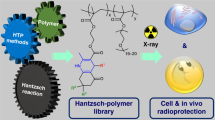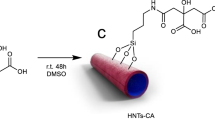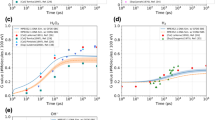Abstract
IN 1944 it was suggested1 that the primary net process in the action of penetrating radiations (γ-rays, X-rays, etc.) on the water molecule consists in its splitting in the following way: which presumably takes place by way of the formation of H2O+ and H2O—. All the known chemical effects in aqueous solutions can be interpreted on this basis1,2, which furthermore permits an adequate description of the biological effects of radiations3,4. Recently, Dainton5 found that acrylonitrile in dilute aqueous solution on irradiation by X-rays or γ-rays shows polymerization, which he attributed to the action of primarily formed hydroxyl radicals (according to the above scheme) in view of the fact that these radicals are known to initiate polymerizations6.
This is a preview of subscription content, access via your institution
Access options
Subscribe to this journal
Receive 51 print issues and online access
$199.00 per year
only $3.90 per issue
Buy this article
- Purchase on SpringerLink
- Instant access to full article PDF
Prices may be subject to local taxes which are calculated during checkout
Similar content being viewed by others
References
Weiss, J., Nature, 153, 748 (1944).
Cf. Lea, E. D., "Actions of Radiations on Living Cells", 47 (Cambridge University Press, 1946).
Weiss, J., Nature, 157, 584 (1946).
Weiss, J., Trans. Farad. Soc., 43, 314 (1947).
Dainton, F. S., Nature, 160, 268 (1947).
Cf. Evans, M. G., et al., Trans. Farad. Soc., 42, 668, 675 (1946).
Cf. Beilstein, 4th ed., 16, 247.
Cf. Haber, F., and Willstätter, R., Ber., 64, 2844 (1931).
Author information
Authors and Affiliations
Rights and permissions
About this article
Cite this article
STEIN, G., WEISS, J. Chemical Effects of Ionizing Radiations. Nature 161, 650 (1948). https://doi.org/10.1038/161650a0
Issue date:
DOI: https://doi.org/10.1038/161650a0
This article is cited by
-
Mitochondria, oxidative DNA damage, and aging
AGE (2000)
-
The Reaction between hydrogenperoxide and iron salts
Experientia (1951)
-
L'action indirecte du rayonnement X et ultra-violet
Experientia (1951)
-
Chemical Effects of Ionizing Radiation in some Gels
Nature (1950)
-
Oxidation by Photochemical Electron Transfer Excitation
Nature (1950)



